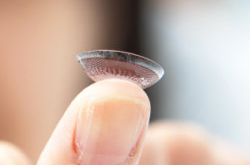A new gene therapy that successfully treated a rare eye disease in clinical trials could prove the key to preventing more common inherited causes of blindness, researchers say.
In six male patients, doctors used a virus to repair a defective gene that causes choroideremia, a degenerative eye disease that can lead to complete blindness by middle age, according to a clinical trial report published online Jan. 16 in The Lancet.
Vision improved for all the patients following the gene therapy, and particularly for two patients with advanced choroideremia, said lead author Robert MacLaren of the Nuffield Laboratory of Ophthalmology at the University of Oxford, and a consultant surgeon at the Oxford Eye Hospital, in England.
“In truth, we did not expect to see such dramatic improvements in visual acuity and so we contacted both patients’ home opticians to get current and historical data on their vision in former years, long before the gene therapy trial started,” MacLaren said in a university news release. “These readings confirmed exactly what we had seen in our study and provided an independent verification.”
While choroideremia is a rare disease, affecting about one in every 50,000 people, doctors believe the process used to treat it could be turned toward more common inherited eye disorders, such as macular degeneration or retinitis pigmentosa.
“This is something that we’ve been trying to accomplish for years in retinal science, and it’s very encouraging,” said Dr. Mark Fromer, an ophthalmologist at Lenox Hill Hospital, in New York City.
Fromer, who was not involved with the new research, predicted that gene therapy could in the future be used to prevent blindness by fixing defective genes in patients before something like macular degeneration can even take root.
“We’ll go from putting a Band-Aid on the lesion to preventing it from happening. This is a new pathway to fix things before they get broken,” said Fromer, who is also the eye surgeon for the National Hockey League’s New York Rangers
Choroideremia is caused by defects in the CHM gene on the X chromosome, which explains why it usually affects boys, according to the background information from the journal. It causes the pigment cells in the eye’s retina to die off, progressively shrinking the retina and slowly reducing vision.
The first signs tend to be seen in boys in late childhood, with the disease slowly progressing until vision is lost. There is currently no cure.
MacLaren and his colleagues engineered a virus that would infect the patient’s retina but, instead of spreading disease, would instead release a DNA payload that would replace the defective gene with a working copy of the gene.
The phase 1 clinical trial involved six patients aged 35 to 63 — two with excellent vision, two with good vision and two with damaged vision, according to the case report. In an operation similar to cataract surgery, doctors surgically detached the patients’ retinas and then injected the virus underneath using a very fine needle.
Six months after the operation, patients with good or excellent vision retained that vision but could see more in the dark when tested. Loss of night vision is an early sign of the disease, MacLaren said.
The two patients with bad vision experienced improvement, and were now able to read two and four more lines on a sight chart.
Those improvements have lasted for two years in one patient and one year in the other, researchers reported.
“It’s too early to say the degeneration has stopped, but the vision we’ve seen in these two patients has been sustained at one year and two years,” MacLaren said in an interview.
Fromer said that the most promising part about gene therapy for eye diseases is that vision loss often occurs very slowly. That means that doctors would have ample time to halt vision loss using a genetic cure.
“You have a lot of time to get that virus into the eye, to correct the defective gene,” Fromer said. “The window is large.”
MacLaren said this research has focused on choroideremia because it is a relatively simple disease caused by just one defective gene.
By proving this type of treatment can work, he added, doctors can then investigate using it to treat more complicated genetic eye disorders in which multiple genes are malfunctioning.
“This is effectively the first flight across the Atlantic,” MacLaren said. “It’s one disease, it’s quite rare, but it represents a big step forward.”
Source: WebMD.com
And visit our sites: drgoldeneye.com
drgoldeneye
Don't forget to check out our YouTube playlist ytplaylist
